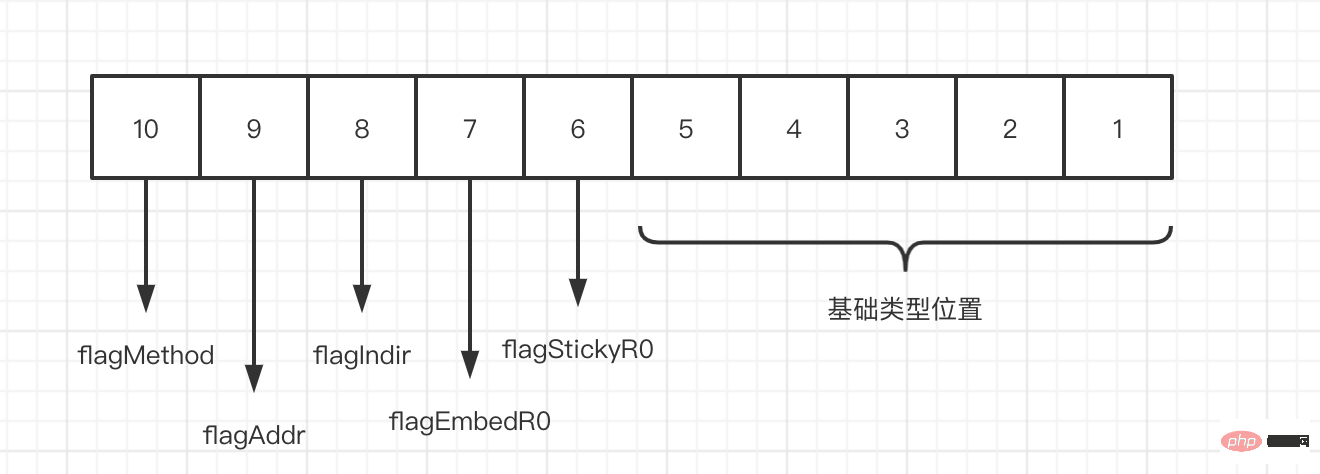

Un article pour comprendre ce qu'est CanSet, CanAddr ?
Qu'est-ce que CanSet
Tout d'abord, nous devons clarifier que CanSet est pour Reflect.Value. Pour convertir une variable ordinaire en reflet.Value, vous devez d'abord utiliser réfléchissant.ValueOf() pour la convertir. Alors pourquoi existe-t-il une méthode aussi « réglable » ? Par exemple, l'exemple suivant :var x float64 = 3.4v := reflect.ValueOf(x)fmt.Println(v.CanSet()) // false
var x float64 = 3.4v := reflect.ValueOf(&x)fmt.Println(v.CanSet()) // false
var x float64 = 3.4v := reflect.ValueOf(&x)fmt.Println(v.Elem().CanSet()) // true
var x float64 = 3.4v := reflect.ValueOf(&x)if v.Elem().CanSet() {
v.Elem().SetFloat(7.1)}fmt.Println(x)Types plus complexes
Pour les tranches, cartes, structures, pointeurs et autres méthodes complexes, j'ai écrit un exemple :package mainimport (
"fmt"
"reflect")type Foo interface {
Name() string}type FooStruct struct {
A string}func (f FooStruct) Name() string {
return f.A}type FooPointer struct {
A string}func (f *FooPointer) Name() string {
return f.A}func main() {
{
// slice
a := []int{1, 2, 3}
val := reflect.ValueOf(&a)
val.Elem().SetLen(2)
val.Elem().Index(0).SetInt(4)
fmt.Println(a) // [4,2]
}
{
// map
a := map[int]string{
1: "foo1",
2: "foo2",
}
val := reflect.ValueOf(&a)
key3 := reflect.ValueOf(3)
val3 := reflect.ValueOf("foo3")
val.Elem().SetMapIndex(key3, val3)
fmt.Println(val) // &map[1:foo1 2:foo2 3:foo3]
}
{
// map
a := map[int]string{
1: "foo1",
2: "foo2",
}
val := reflect.ValueOf(a)
key3 := reflect.ValueOf(3)
val3 := reflect.ValueOf("foo3")
val.SetMapIndex(key3, val3)
fmt.Println(val) // &map[1:foo1 2:foo2 3:foo3]
}
{
// struct
a := FooStruct{}
val := reflect.ValueOf(&a)
val.Elem().FieldByName("A").SetString("foo2")
fmt.Println(a) // {foo2}
}
{
// pointer
a := &FooPointer{}
val := reflect.ValueOf(a)
val.Elem().FieldByName("A").SetString("foo2")
fmt.Println(a) //&{foo2}
}}CanAddr
Comme vous pouvez le voir dans le package Reflect, en plus de CanSet, il existe également une méthode CanAddr. Quelle est la différence entre les deux ? La différence entre la méthode CanAddr et la méthode CanSet est que pour certains champs privés de la structure, nous pouvons obtenir son adresse, mais nous ne pouvons pas la définir. Par exemple, l'exemple suivant :package mainimport (
"fmt"
"reflect")type FooStruct struct {
A string
b int}func main() {
{
// struct
a := FooStruct{}
val := reflect.ValueOf(&a)
fmt.Println(val.Elem().FieldByName("b").CanSet()) // false
fmt.Println(val.Elem().FieldByName("b").CanAddr()) // true
}}Code source
Supposons que nous souhaitions implémenter cet élément de valeur CanSet ou CanAddr, nous utiliserons très probablement la marque de bit de drapeau. C'est effectivement le cas. Regardons d'abord la structure de Value :type Value struct {
typ *rtype
ptr unsafe.Pointer
flag}type flag uintptr
const ( Invalid Kind = iota Bool Int Int8 Int16 Int32 Int64 Uint Uint8 Uint16 Uint32 Uint64 Uintptr Float32 Float64 Complex64 Complex128 Array Chan Func Interface Map Ptr Slice String Struct UnsafePointer)
所以使用5位(2^5-1=63)就足够放这么多类型了。所以 flag 的低5位是结构类型。
第六位 flagStickyRO: 标记是否是结构体内部私有属性
第七位 flagEmbedR0: 标记是否是嵌套结构体内部私有属性
第八位 flagIndir: 标记 value 的ptr是否是保存了一个指针
第九位 flagAddr: 标记这个 value 是否可寻址
第十位 flagMethod: 标记 value 是个匿名函数

其中比较不好理解的就是 flagStickyRO,flagEmbedR0
看下面这个例子:
type FooStruct struct {
A string
b int}type BarStruct struct {
FooStruct}{
b := BarStruct{}
val := reflect.ValueOf(&b)
c := val.Elem().FieldByName("b")
fmt.Println(c.CanAddr())}这个例子中的 c 的 flagEmbedR0 标记位就是1了。
所以我们再回去看 CanSet 和 CanAddr 方法
func (v Value) CanAddr() bool {
return v.flag&flagAddr != 0}func (v Value) CanSet() bool {
return v.flag&(flagAddr|flagRO) == flagAddr}他们的方法就是把 value 的 flag 和 flagAddr 或者 flagRO (flagStickyRO,flagEmbedR0) 做“与”操作。
而他们的区别就是是否判断 flagRO 的两个位。所以他们的不同换句话说就是“判断这个 Value 是否是私有属性”,私有属性是只读的。不能Set。
应用
在开发 collection (https://github.com/jianfengye/collection)库的过程中,我就用到这么一个方法。我希望设计一个方法 func (arr *ObjPointCollection) ToObjs(objs interface{}) error,这个方法能将 ObjPointCollection 中的 objs reflect.Value 设置为参数 objs 中。
func (arr *ObjPointCollection) ToObjs(objs interface{}) error {
arr.mustNotBeBaseType()
objVal := reflect.ValueOf(objs)
if objVal.Elem().CanSet() {
objVal.Elem().Set(arr.objs)
return nil }
return errors.New("element should be can set")}使用方法:
func TestObjPointCollection_ToObjs(t *testing.T) {
a1 := &Foo{A: "a1", B: 1}
a2 := &Foo{A: "a2", B: 2}
a3 := &Foo{A: "a3", B: 3}
bArr := []*Foo{}
objColl := NewObjPointCollection([]*Foo{a1, a2, a3})
err := objColl.ToObjs(&bArr)
if err != nil {
t.Fatal(err)
}
if len(bArr) != 3 {
t.Fatal("toObjs error len")
}
if bArr[1].A != "a2" {
t.Fatal("toObjs error copy")
}}总结
CanAddr 和 CanSet 刚接触的时候是会有一些懵逼,还是需要稍微理解下 reflect.Value 的 flag 就能完全理解了。
Ce qui précède est le contenu détaillé de. pour plus d'informations, suivez d'autres articles connexes sur le site Web de PHP en chinois!
 Comment définir des variables dans Golang
Comment définir des variables dans Golang
 Quelles sont les méthodes de conversion de données dans Golang ?
Quelles sont les méthodes de conversion de données dans Golang ?
 Quelles sont les bibliothèques couramment utilisées dans Golang ?
Quelles sont les bibliothèques couramment utilisées dans Golang ?
 Quelle est la différence entre golang et python
Quelle est la différence entre golang et python
 Introduction aux logiciels de virtualisation
Introduction aux logiciels de virtualisation
 ^quxjg$c
^quxjg$c
 site officiel de notepad++
site officiel de notepad++
 Le rôle du mode Ne pas déranger d'Apple
Le rôle du mode Ne pas déranger d'Apple
 Utilisation de caractères arbitraires dans les expressions régulières
Utilisation de caractères arbitraires dans les expressions régulières